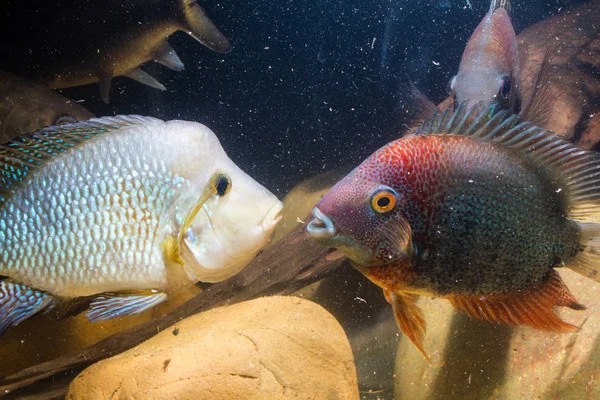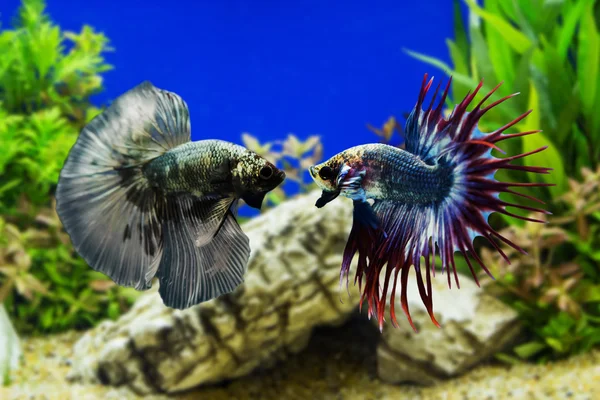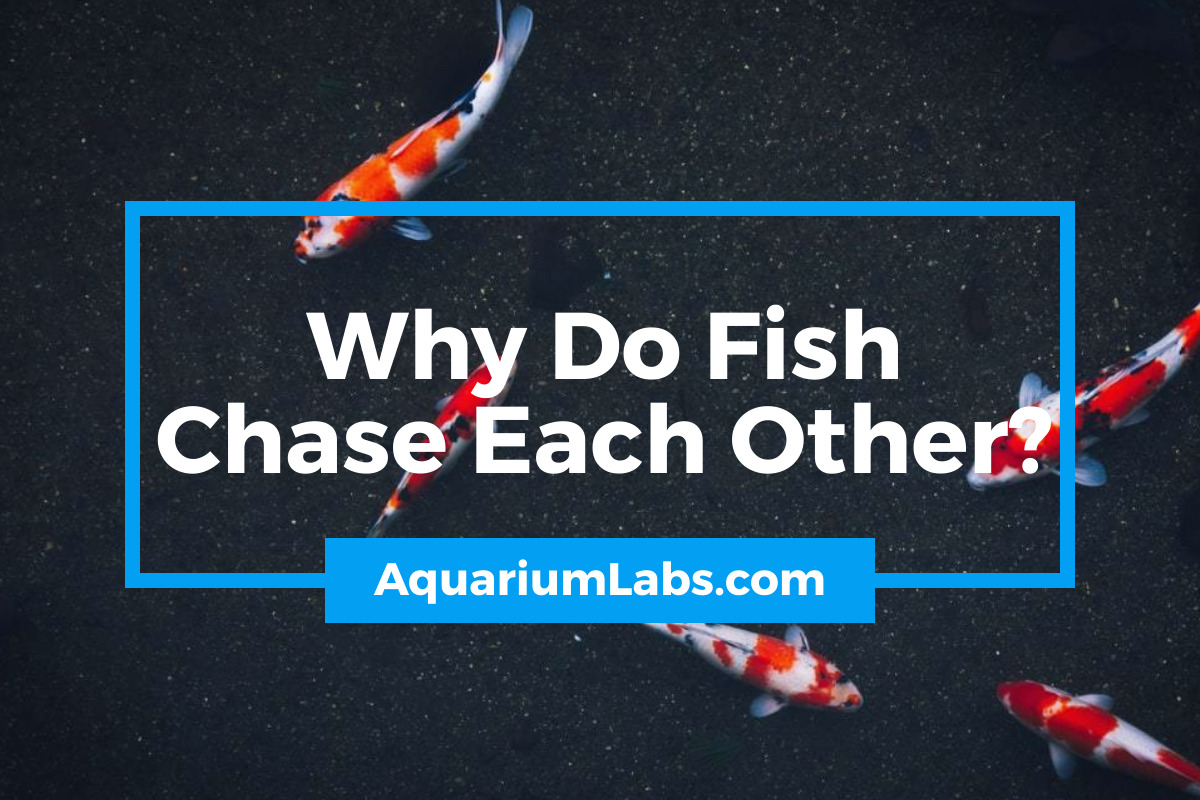Whether you have all fish of the same species or a mixture of fish in community tanks, there is bound to be a little chasing at times. But fish have very different behaviors that make it unclear why they are chasing each other. Are they being aggressive? Territorial fish chasing their tank mates can cause significant stress. Or are they trying to breed with another of their kind?
Why do fish chase each other? Let’s look into some of the most common reasons why fish chasing is seen in an aquarium. And whether you should be happy or need to step in and change something about your fish tank!
Is it Breeding Time for Your Fish?

One big reason why fish chasing can be a good thing is when a male and female are interested in spawning. Or, much more likely, the male is very interested, but the female fish isn’t having it. So he is chasing her around the tank, trying to wear her down.
The best way to tell if a fish chase might lead to spawning is to understand how sexes look with the different species of fish that you have. Male fish tend to be larger and more colorful than female fish but not always. Some fish may have longer fins as well or a thick hump around the head, like male cichlids.
Male fish are also usually the ones trying to chase a female fish around the tank. So if you have fish in your tank that are almost impossible to sex visually, like tetras and danios, then fish behavior is your best visual clue!
Do I Have Aggressive Fish?
Sometimes there is no easy solution to stop chasing behavior from happening. Especially if you have aggressive fish that are not always tolerant of their tank mates.
The problems with territorial fish are always made worse when you have too many fish, or the tank is too small. Less dominant fish or more peaceful fish will be harassed mercilessly in these settings.
First-time cichlid keepers often run into these problems. Even smaller fish like Convict Cichlids (Amatitlania nigrofasciata) are extremely aggressive compared to nearly all the fish you will find in the average pet store. They will bully weaker fish mercilessly.

Big fish like Jaguar Cichlids (Parachromis managuensis) have the power and teeth to simply kill any tank mates they don’t like. And if they end up breeding, your other fish will all be forced into the far corners of the fish tank with bites and endless chasing.
So how can we manage fish chasing when we have fish that love chasing all of the time?
Managing Aggressive Behavior in Territorial Fish
It may be that you simply need a bigger space for your pets. This way, the other fish that are less aggressive have room to avoid the turf claimed by your most dominant fish.
Tank decorations are another effective way to manage aggressive behavior in territorial fish. A group of aggressive fish in the same tank will try and establish boundaries for each territory. Rocks, plants, driftwood, and other elements help these fish form natural borders that maintain harmony.
Just be sure that you don’t add too many obstacles to your aquarium. Every item that you add to a fish tank reduces the water volume.
And the less water volume you have, the easier it is for pollutants like ammonia and nitrite to negatively impact water quality. Aggression in aquarium fish is bad, but so is poor water quality!

If you are hopelessly in love with a semi-aggressive or aggressive fish, then have you tried making it the new fish? One common way to reduce aggression is to add the most territorial fish last. If you add an aggressive fish to an aquarium first, it may see the entire tank as its territory.
After all, there are no other fish around! But it will then bully anything you add to the aquarium, even other fish species. And since your new fish are still trying to settle in, they will be forced into a lesser role.
Lastly, if you have incompatible tank mates, you may need to move weaker fish to different tanks. Keeping a hyper-aggressive cichlid with a gourami that is very similar in shape and color but can’t fight back would be cruel.
Fish compatibility does not always work out, so setting up a separate tank may be what’s needed.
Competition for Food
Are you offering enough food for your fish? Competition for food can result in a lot of fish chase behavior. Especially in fish of the same species.
Often the dominant fish will immediately try and bully subdominant fish that try to eat. This way, he remains the biggest and strongest fish. So how can we make sure that other fish get to eat as well?
When feeding time comes around, try feeding the fish in your tank from opposite ends at the same time!
Two sets of feeding rings can help keep any floating food in place so the dominant fish that is eating in one area won’t be able to get close enough to chase away his rivals eating elsewhere.
It does mean that you may end up adding more food to the tank than you normally do. So be careful not to overfeed your fish. We don’t want fat aquarium fish or poor water quality!
What If My Fish Is Chasing Other Fish Species
When you see a fish chase other fish, they will usually be of the same species. But sometimes a fish will chase other fish even if they aren’t the same kind.
How can I find good community fish that aren’t so aggressive towards their tank mates?
Choosing Good Community Fish
Fish that are solitary, predatory, or territorial are usually the ones most likely to chase others. Cichlids, many catfish, large cyprinids, bettas, and certain gouramis tend to be famous for chasing other fish, even if they aren’t like them. All of these fish have social or territorial behavior.
Schooling fish are almost always great for community tanks because they focus all their attention on each other. Occasionally you may see some squabbling or even nips in “peaceful” fish like Neon Tetras.
Livebearers will chase each other, especially when a male fish is looking to breed with a female fish. But they almost never chase or bother their tank mates!

Small barbs like Cherry Barbs are another great choice for community tanks. And always look into smaller fish from more aggressive groups. Dwarf cichlids and gouramis are good additions to most fish tanks, especially when they have enough space to claim a tiny turf of their own!
Are My Fish Playing or Fighting?
It is hard to determine if fish play or not. It is easier to see play in mammals like dogs, cats, and even birds. But fish are so different from us that seeing any activity as play is almost impossible.
Since we are all pet owners, let’s be charitable and assume that fish do play with each other and even their tank mates.
We also know for a fact that fish can be aggressive rather than playful. Since we know what aggression is like, how can we determine whether a chase is harmless “play?”
Signs Your Fish Chasing Behavior is Harmless
Watch how a fish swimming into a chase behaves beforehand. How does it hold its fins? Many fish telegraph their actions by holding their fins erect or outwards.
This is a threat display meant to make the fish look larger than it actually is, like men puffing out their chests or cats raising their backs and fur before fighting.
A fish chasing for play will lazily swim towards the other fish. It won’t spread its fins in a threat display but keep them held naturally as it swims. An aggressive chase is also very fast, sometimes so fast you won’t be able to keep up.
The fish that recognizes a playful chase may not even flee; the two fish may make physical contact. One fish might then bump the other, but it does not go any further than this.

Sometimes aquarists mistake lazy aggression for play, however. Lone fish may decide to tolerate tank mates that are very different from them. Semi-aggressive large cichlids like Oscars often do this. They will swim slowly towards a transgressor, who will slowly flee the other way. And then that’s the end of it.
The cichlid is still territorial, but it’s just not interested in spending more energy catching the intruder. So long as the other fish in your tank has room to swim without being chased and aren’t visibly stressed, then this is not a problem!
Signs Your Fish Chasing Behavior is Aggressive
So how can we tell if your fish are just playing or actually being aggressive? Are there two fish of the same sex involved in the chase? That almost always means that you are looking at a social or breeding dispute of some kind where one fish is establishing dominance over another of the same sex.
Do you see visible signs of damage to the fish being chased? Missing scales and nipped fins are the most common signs, but sometimes you may even see missing eyes if one fish has sharp teeth. Any visible damage is a warning sign that it may be time to remove a fish to a new tank.
And even if you don’t actually see a chase happening, is there a fish that is sticking to hiding places? Fish that feel threatened by a pursuit will try and stay hidden since they can’t actually leave the area like they would in nature.
A fish that hides even when it is time to eat really should be moved to its own space where one fish won’t bully it to the point of starvation.
Wrapping Things Up
Tropical fish chasing each other can be hard to sort out. Are the fish playing, being aggressive, trying to breed, or something else entirely? If only fish compatibility were an easy thing to sort out…But fish can be as complicated as any pet when it comes to their social dynamics!
Hopefully, the tips and suggestions I’ve included in this guide will help you understand how to reduce aggression, territoriality, or make it easier for male fish and female fish to breed. Or, if it comes down to it, help a constantly bullied fish find a new home!
Related FAQs:


